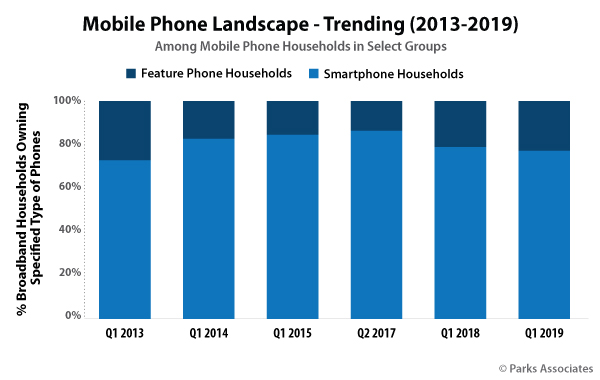Basic Phones Making a Comeback
We’ve all heard the expression before—smartphones have peaked. And it's true; Parks Associates consumer surveys find that smartphone adoption in the US reached its highest point in 2017, and has slowly declined ever since.
Going hand in hand with smartphone decline is a second, more counterintuitive trend. Consumers are going back to basics—basic phones, that is. Between 2017 and 2019, the percentage of broadband households with mobile phone service but no smartphones rose from 15% to 22%—an increase of 7 percentage points in only two years.

Contrary to expectations, this increase in feature phone adoption is taking place not just among lower income households but among households of all income levels, with adoption of basic phones doubling among households earning over $100K/year between 2017 and 2019. Likewise, adoption is growing more rapidly among younger heads of households than among older heads of households. Between 2017 and 2019, basic phone adoption doubled among heads of households 18-44, even as smartphone adoption grew among those age 65+.
Looking at the technology adoption cycle, we are seeing a bell curve of smartphone adoption. Adoption of smartphones is highest in the middle of the curve—these are the early adopters and early majority. However, at the beginning of the curve, the innovators are beginning to turn away from smartphones and back to basic phones. But why? We have a few hypotheses.
Alongside a general trend of increasing smartphone prices, there’s also been a cultural backlash against tech in recent years. Consumers are urged to unplug, unwind, and cut back on their screen time. Privacy infringements and divisive content on social media are also encouraging consumers to step away and dial down on their consumption. While the PC remains a necessity of life for many consumers, smartphones are still optional—and the easiest way to avoid feeling bad about that Instagram influencer’s travels in the South Pacific is to ditch the option to follow her adventures at all.
So what does this mean? For smartphone OEMs, it’s a sign that points to potentially lower sales and decreased margins in an already stressed market. For mobile carriers, it suggests that consumers may begin to downgrade their mobile plans. After all, if you can’t stream video, what exactly do you need an unlimited data plan for? In an increasingly mobile-first world, this could be a signal to tap the brakes.
Further Reading:
- Mobile Service Churn: Managing Consumer Expectations
- Market Snapshot: Smartphones and Mobile Services
- Smartphone-based systems hurting overall VR product market
Next: Connected Cars: Extending Functions in the Home
Previous: CES 2018: Voice Assistant Showdown
Comments
-
Be the first to leave a comment.
Post a Comment
Have a comment? Login or create an account to start a discussion.


